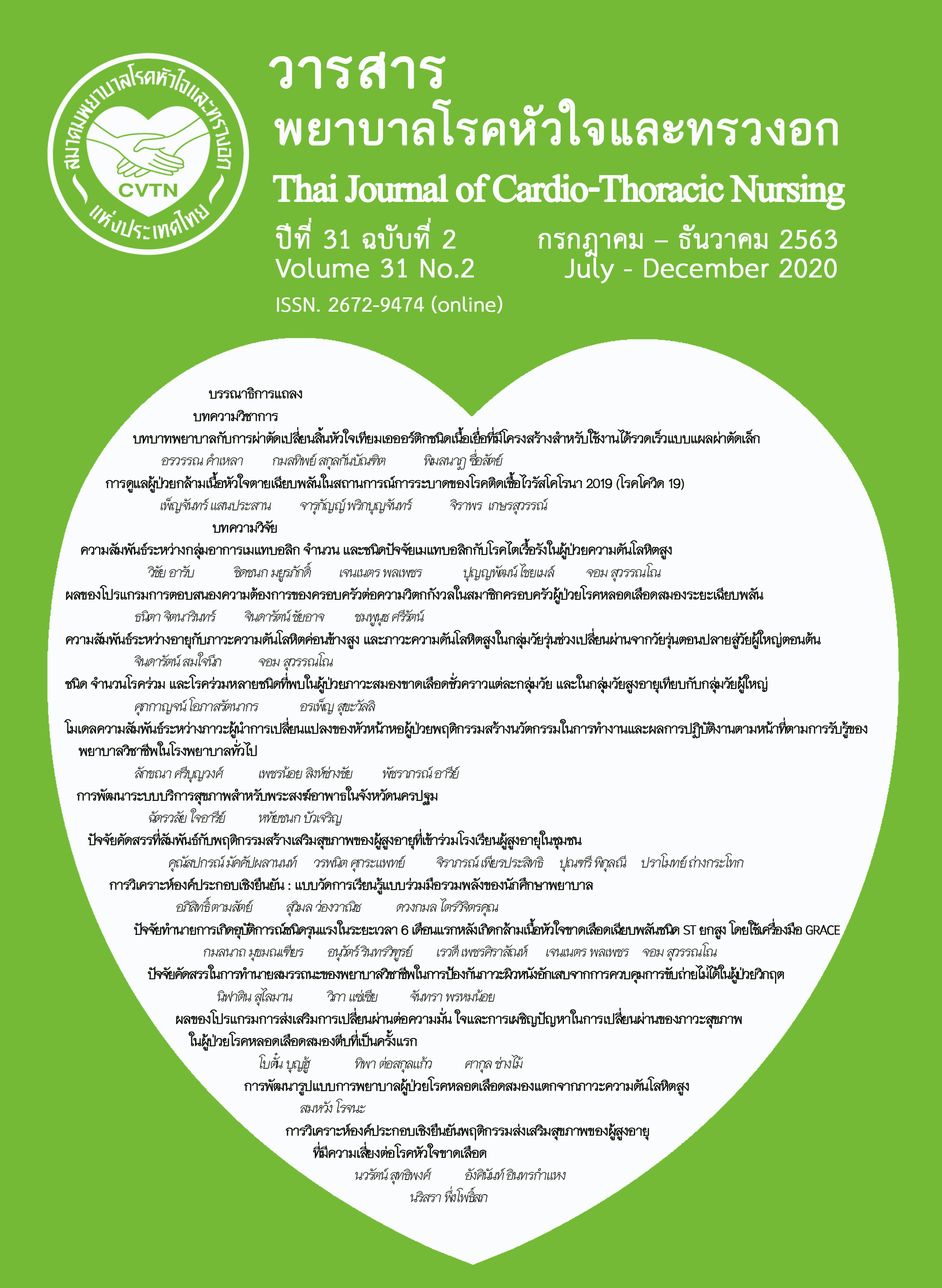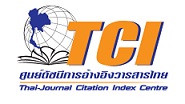โมเดลความสัมพันธ์ระหว่างภาวะผู้นำการเปลี่ยนแปลงของหัวหน้าหอผู้ป่วย พฤติกรรมสร้างนวัตกรรมในการทำงานและผลการปฏิบัติงานตามหน้าที่ ตามการรับรู้ของพยาบาลวิชาชีพในโรงพยาบาลทั่วไป
คำสำคัญ:
ผลการปฏิบัติงานตามหน้าที่ของพยาบาลวิชาชีพ, ภาวะผู้นำการเปลี่ยนแปลง, พฤติกรรมสร้างนวัตกรรมในการทำงาน, หัวหน้าหอผู้ป่วย, การรับรู้ของพยาบาลวิชาชีพบทคัดย่อ
การวิจัยนี้ครั้งนี้เป็นการวิจัยเชิงปริมาณ มีวัตถุประสงค์เพื่อวิเคราะห์โมเดลความสัมพันธ์ระหว่างภาวะผู้นำการเปลี่ยนแปลงของหัวหน้าหอผู้ป่วย พฤติกรรมสร้างนวัตกรรมในการทำงานและผลการปฏิบัติงานตามหน้าที่ ตามการรับรู้ของพยาบาลวิชาชีพ โรงพยาบาลทั่วไป กลุ่มตัวอย่างเป็นพยาบาลวิชาชีพ เลือกกลุ่มตัวอย่างแบบหลายขั้นตอน จำนวน 374 คน เครื่องมือที่ใช้ในการวิจัย ประกอบด้วย แบบสอบถามภาวะผู้นำการเปลี่ยนแปลง พฤติกรรมสร้างนวัตกรรมในการทำงานและผลการปฏิบัติงานตามหน้าที่ของพยาบาลวิชาชีพ วิเคราะห์ข้อมูลด้วยสถิติเชิงพรรณนาและการวิเคราะห์โมเดลสมการโครงสร้าง
ผลจากการวิจัย พบว่า ภาวะผู้นำการเปลี่ยนแปลง พฤติกรรมสร้างนวัตกรรมในการทำงานและผลการปฏิบัติงานตามหน้าที่อยู่ในระดับมาก (mean = 3.04, SD = .53; mean = 2.69, SD = .54; mean = 3.34, SD = .40) ตามลำดับ ภาวะผู้นำการเปลี่ยนแปลงและพฤติกรรมสร้างนวัตกรรมในการทำงานมีอิทธิพลทางตรงกับผลการปฏิบัติงานตามหน้าที่ของพยาบาลวิชาชีพ (β=.28, p<.01; β=.33, p<.01) โดยภาวะผู้นำการเปลี่ยนแปลงมีอิทธิพลทางตรงกับพฤติกรรมสร้างนวัตกรรมในการทำงาน (β=.45, p<.01) และมีอิทธิพลทางอ้อมกับผลการปฏิบัติงานตามหน้าที่ของพยาบาลวิชาชีพโดยผ่านพฤติกรรมสร้างนวัตกรรมในการทำงาน (β=.15, p<.01) โมเดลเชิงโครงสร้างของผลการปฏิบัติงานตามหน้าที่ของพยาบาลวิชาชีพมีความสอดคล้องกับข้อมูลเชิงประจักษ์ (χ2/df =2.51, GFI=0.95, CFI=0.99, RMR=0.045, RMSEA=0.064)
ข้อเสนอแนะจากการศึกษานี้ ผู้บริหารทางการพยาบาลควรจัดให้มีหลักสูตรการเตรียมความพร้อมการเข้าสู่ตำแหน่งหัวหน้าหอผู้ป่วย ที่เน้นภาวะผู้นำการเปลี่ยนแปลง และส่งเสริมพฤติกรรมสร้างนวัตกรรมในการทำงานให้แก่พยาบาลวิชาชีพที่เพิ่มผลลัพธ์ต่อการปฏิบัติงานตามหน้าที่ของพยาบาลวิชาชีพ
References
Koopmans L. Measuring individual work performance. Zutphen: CPI Koninklijke Wohrmann; 2014.
Ibrahim SAEl-A, Ibrahim El Sayed R, Attala MM, Elmezin NK. Relationship between head nurses' leadership styles and staff nurses' job performance. IOSR-JNHS. 2016; 5(1): 66-74.
World Health Organization. The world health report 2008: primary health care now more than ever. World Health Report World Health Organization; 2008. [cited 2019 Oct 10]. Available from: https://www.who.int/whr/2008/whr08_en.pdf.
Rahiman H, Kodikal R. Impact of Employee Work Related Attitudes on Job Performance. BJEFM. 2017; 13 (2): 93-105.
Sawaengdee K. Crisis shortage of professional nurses in health service units the office of the permanent secretary for health: policy recommendations. Journal of Public Health. 2017; 26(2): 456 – 68. (in Thai).
Nantsupawat R, Wichaikhum O, Nantsupawat A. The relationship between nurses’ extended work hours and patient, nurse, and organizational outcomes in general hospital. Nursing Journal. 2014; 41(4): 58-69. (in Thai).
Amornprompakdee A. Report of important nursing information 2013 - 2017. 2018 [cited 2018 Sep 20]. Available from: http://www.nursing.go.th/ITNurse/Report2556-2560.pdf.
Jyoti J, Bhau S. Impact of transformational leadership on job performance: mediating role of leader–member exchange and relational identification. SAGE Open. 2015; 1(2): 1-13. [cited 2018 Sep 7]; Available from: https://journals.sagepub.com/doi/pdf/10.1177/2158244015612518
Aryee S, Walumbwa FO, Zhou Q, Hartnell CA. Transformational leadership, innovative behavior, and task performance: test of mediation and moderation processes. Hum Perform. 2012; 25: 1–25.
Harlianto J, Rudi, Afandy D. The role of leaders in stimulating innovative work behavior and its impacts towards job performance (case study: PT. XYZ). Int. J. Eng. Technol. 2018; 7(3.30): 571-74. [cited 2018 Sep 4]; Available from: https://www.sciencepubco.com/index.php/ijet/article/view/18433
Kaya N, Turanb N, Aydin GO. World conference on technology, innovation and entrepreneurship a concept analysis of innovation in nursing. Procedia Soc Behav Sci. 2015; 195: 1674 – 78. [cited 2018 Mar 5]; Available from: https://cyberleninka.org/article/n/1041644
Al-Harthy FN, Yusof NA. The impact of transformational leadership style on employee job performance: the mediating effect of training. IJSR.NET. 2013; 5(6): 499 – 503. [cited 2018 Sep 16]; Available from: https://pdfs.semanticscholar.org/0590/601cce6b91cd43a0ce9d42e4356e0fd67001.pdf
Bass BM. Bass and Stogdill’s handbook of leadership: theory, research and managerial applications. New York: Free Press; 1990.
De Jong JP, Den Hartog DN. Measuring innovative work behaviour. Creativ Innovat Manag. 2010; 19(1): 23–36.
Greenslade JH, Jimmieson NL. Distinguishing between task and contextual performance for nurses: development of a job performance scale. J Adv Nurs. 2007; 58(6): 602–11.
Krejcie RV, Morgan DW. Determining sample size for research activities. Educ Psychol Meas. 1970; 30(3): 607 – 610.
Wongcharoen W. The Structural Equation Model of Leadership of In-Patient Unit Head Nurses as Perceived by Professional Nurses, Nurses’ Work Engagement, and Job Performance of Professional Nurses in Community Hospitals. [Doctoral dissertation of nursing management]. Nakhonpathom: Christian University; 2018. (in Thai).
Jaiswal NK, Dhar RL. Transformational leadership, innovation climate, creative self-efficacy and employee creativity: A multilevel study. Int J Hospit Manag. 2015; 51: 30-41.
Best JW, Kahn JV. Research in Education,10th Edition. New York: Pearson; 2016.
Hair JF, Babin BJ, Black WC, Anderson RE. Multivariate data analysis. 8th ed. New Delhi: Cengage; 2018.
Mueller RO. Basic principles of structural equation modeling: An introduction to LISREL and EQS. New York: Springer; 1996.
Afsar B, Badir FY, Saeed BB. Transformational leadership and innovative work behavior. Ind Manag Data Syst. 2014; 114(8): 1270-1300.
Choi SB, Kim K, Ebrahim Ullah SM, Kang SW. How transformational leadership facilitates innovative behavior of Korean workers. Person Rev. 2016; 45(3): 459–79.
Contreras F, Espinosa JC, Dornberge U, Cuero Acosta YA. Leadership and employees’ innovative work behavior: test of a mediation and moderation mode. Asian Soc Sci. 2017; 13(9): 9 – 25.
Khan M, Aslam N, Riaz M. Leadership styles as predictors of innovative work behavior. PJSCP. 2012; 9(2): 17–22. [cited 2018 Sep 25]; Available from: https://www.researchgate.net/publication/234092637_Leadership_Styles_as_Predictors_of_Innovative_Work_Behavior
Schieltz KM. Impacting clinical and professional behavior through basic behavioral processes: A translation of behavioral persistence in and out of clinic. University Missouri: College of Education; 2018. [cited 2019 Jun 10]. Available from: https://thebaca.com/wp-content/uploads/2018/04/K-Schieltz-Symposium-2018.pdf.
Dörner N. Innovative work behavior: the roles of employee expectations and effects on job performance. [Doctoral dissertation of management]. Bamberg: St.Gallen University; 2012.
Chatchawan R, Trichandhara K, Rinthaisong I. Factors affecting innovative work behavior of employees in local administrative organizations in the south of Thailand. Journal of Southern Technology. 2018; 11(1): 113 – 24. (in Thai).
Majumdar B, Ray A. Transformational leadership and innovative work behaviour. J. Indian Acad. Appl. Psychol. 2011; 37(1): 140 – 48. [cited 2018 Nov 26]; Available from: https://www.researchgate.net/publication/236619084_Transformational_Leadership_and_Innovative_Work_Behaviour
Shi J. Influence of passion on innovative behavior: An empirical examination in people Republic of China. Afr J Bus Manag. 2012; 6(30): 8889 - 96.
Downloads
เผยแพร่แล้ว
How to Cite
ฉบับ
บท
License
บทความนี้ยังไม่เคยตีพิมพ์หรืออยู่ในระหว่างส่งไปตีพิมพ์ในวารสารอื่น ๆ มาก่อน และกองบรรณาธิการขอสงวนสิทธิ์ในการตรวจทาน และแก้ไขต้นฉบับตามเกณฑ์ของวารสาร ในกรณีที่เรื่องของท่านได้ได้รับการตีพิมพ์ในวารสารฉบับนี้ถือว่าเป็น ลิขสิทธิ์ของวารสารพยาบาลโรคหัวใจและทรวงอก





